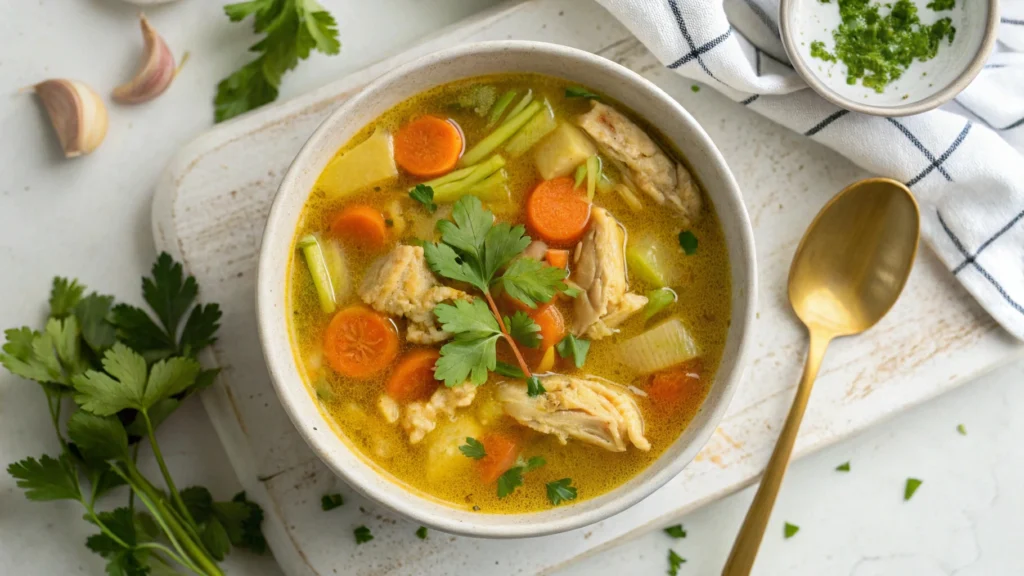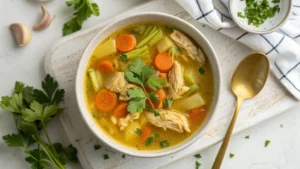Chicken soup is the ultimate comfort food, a warm hug in a bowl that soothes the soul. But what happens when you supercharge this classic with turmeric and ginger, two of nature’s most potent anti-inflammatory ingredients? You get a golden elixir that’s not only delicious but also a powerhouse for your health. Whether you’re fighting a cold, seeking a high-protein meal, or just craving something cozy, this anti-inflammatory turmeric ginger chicken soup is your go-to. In this comprehensive guide, we’ll dive into the science behind these healing spices, share a foolproof recipe, explore creative variations, and offer expert tips to make every spoonful burst with flavor and nutrition. Ready to elevate your soup game? Let’s get cooking!
The Power of Turmeric and Ginger
Why do turmeric and ginger steal the spotlight in this soup? These vibrant spices aren’t just flavor enhancers; they’re backed by science for their remarkable health benefits. Let’s break it down.
Turmeric: The Golden Healer
Turmeric, with its active compound curcumin, is a superstar in the world of anti-inflammatory foods. Research suggests curcumin may reduce chronic inflammation, a root cause of conditions like arthritis, heart disease, and even some cancers. A 2017 study published in Foods found that curcumin has antioxidant, anti-inflammatory, and immune-boosting properties. But here’s the kicker: pairing turmeric with black pepper enhances curcumin’s bioavailability, making it easier for your body to absorb.
“Turmeric’s curcumin is a potent anti-inflammatory, but pairing it with black pepper can increase its absorption by up to 2,000%.”
Dr. Andrew Weil
Ginger: The Soothing Spice
Ginger isn’t just for holiday cookies it’s a digestive dynamo and inflammation fighter. Studies show ginger’s active compounds, like gingerol, can ease nausea, reduce muscle pain, and support immune health. A 2019 review in Nutrients highlighted ginger’s role in alleviating digestive issues and boosting immunity, making it a perfect addition to a healing soup.
The Dynamic Duo
When turmeric and ginger team up, their anti-inflammatory effects amplify, creating a synergy that’s greater than the sum of its parts. This duo is like the Batman and Robin of your kitchen, fighting inflammation and boosting your well-being with every spoonful.
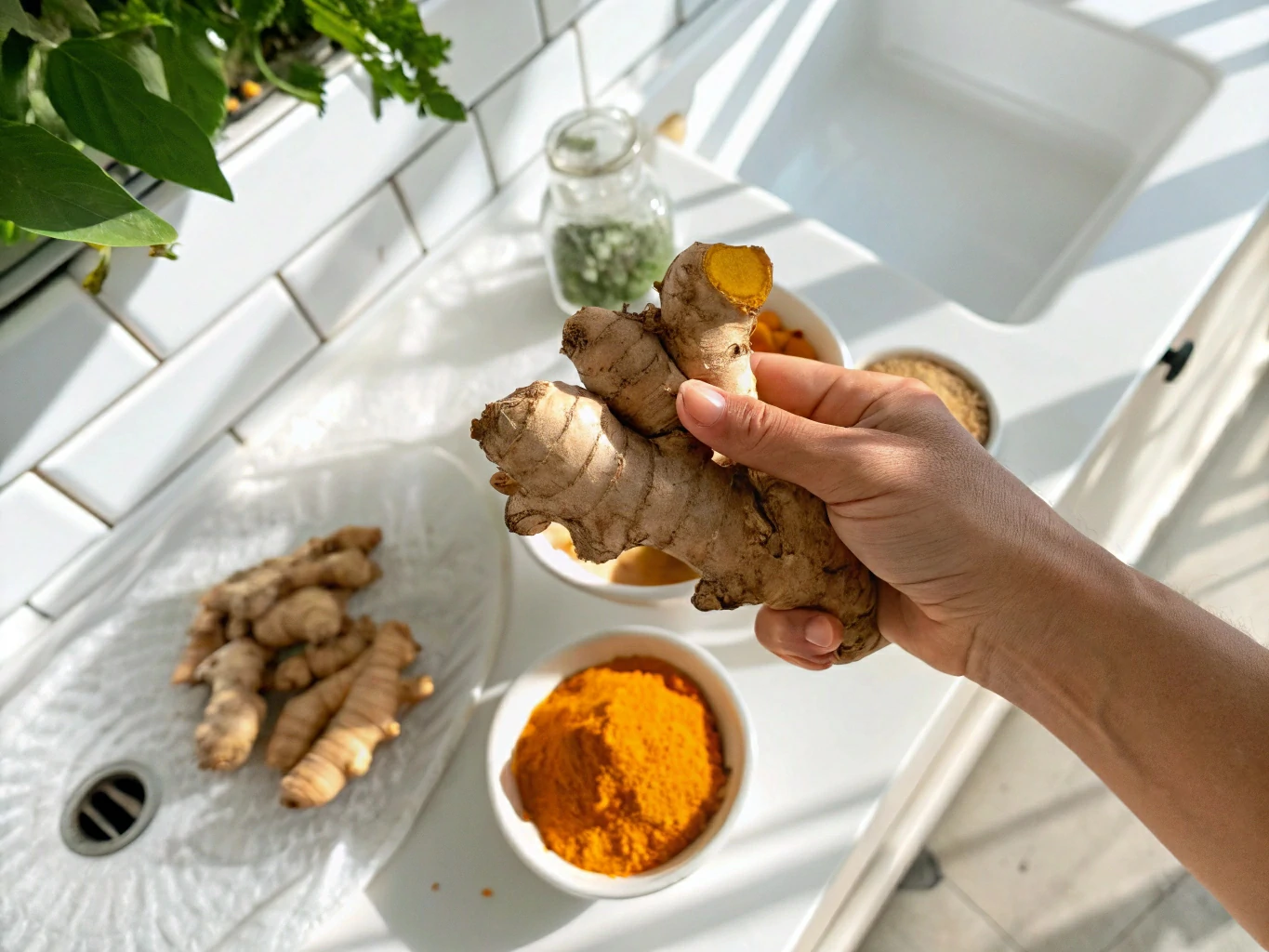
Learn more about Turmeric’s Health Benefits in this comprehensive study.
The Perfect Anti-Inflammatory Chicken Soup Recipe
This turmeric ginger chicken soup recipe is your ticket to a nourishing, flavor-packed meal that’s easy to whip up. Packed with high-protein chicken, vibrant vegetables, and those magical spices, it’s a one-pot wonder that’s perfect for weeknight dinners or meal prep. Here’s how to make it.
Ingredients (Serves 7)
- 2 tbsp olive oil
- 1 large yellow onion, chopped
- 4 large carrots, chopped
- 3 celery stalks, chopped
- 2 cups shredded cabbage
- 3 cloves garlic, minced
- 4 tbsp fresh ginger, minced
- 1 tsp ground turmeric
- 1 tsp onion powder
- 1/2 tsp dried rosemary
- 1/2 tsp dried thyme
- Kosher salt and black pepper to taste
- 9-10 cups low-sodium chicken broth
- 2.5 lbs boneless, skinless chicken breast, cubed
- 2 cups frozen peas
Instructions
- Sauté the Veggies: In a large stock pot, heat olive oil over medium-high heat. Add onion, carrots, celery, and cabbage. Cook, stirring occasionally, until softened, about 6-7 minutes.
- Add Aromatics: Stir in garlic, ginger, turmeric, onion powder, rosemary, thyme, salt, and black pepper. Cook for 2 minutes, letting the spices bloom.
- Simmer the Soup: Pour in chicken broth and bring to a boil. Add cubed chicken breast and reduce to a simmer. Cook until chicken is tender, about 15 minutes.
- Shred and Finish: Remove chicken, shred it with two forks, and return it to the pot. Add peas and simmer for 10 minutes until peas are warmed through.
- Taste and Serve: Adjust seasonings with additional salt and pepper. Serve hot, garnished with a crack of black pepper or fresh herbs.
Nutritional Analysis (Per Serving)
| Nutrient | Amount |
|---|---|
| Calories | ~343 kcal |
| Protein | ~44g |
| Carbohydrates | ~19g |
| Fat | ~10g |
Looking for more healthy recipes? Try our Healthy Pancake Mixes for a nutritious breakfast.
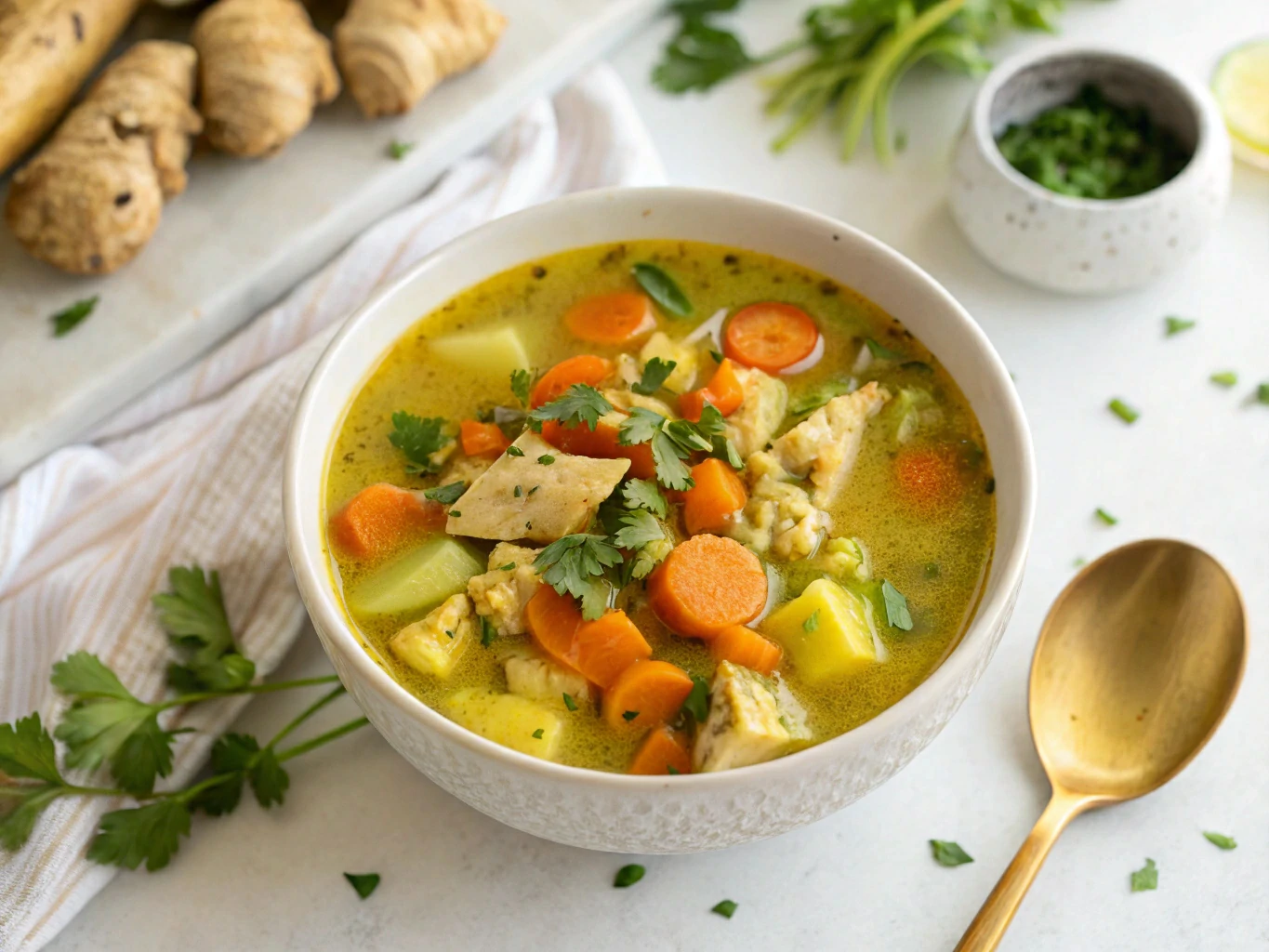
Variations and Add-Ins
One of the best things about chicken soup is its versatility. Whether you’re catering to dietary preferences or just want to mix things up, here are some ways to customize your turmeric ginger chicken soup.
Protein Options
- Turkey: Swap chicken for turkey breast for a lean, flavorful twist.
- Tofu: Go plant-based with firm tofu cubes for a vegetarian option.
Vegetable Additions
- Spinach or Kale: Add leafy greens in the last 2 minutes for a nutrient boost.
- Bok Choy: Toss in for a crunchy, Asian-inspired touch.
- Zucchini: Dice and simmer for extra veggies.
Grain Options
- Rice: Stir in cooked jasmine or brown rice for heartiness.
- Udon Noodles: Add chewy noodles for a Japanese flair.
- Orzo: Toss in this tiny pasta for a comforting texture.
Spice Variations
- Coriander: Adds a citrusy warmth.
- Cumin: Brings earthy depth.
- Chili Flakes: For a spicy kick.
Explore more Vegetarian Soup Recipes for plant-based inspiration.
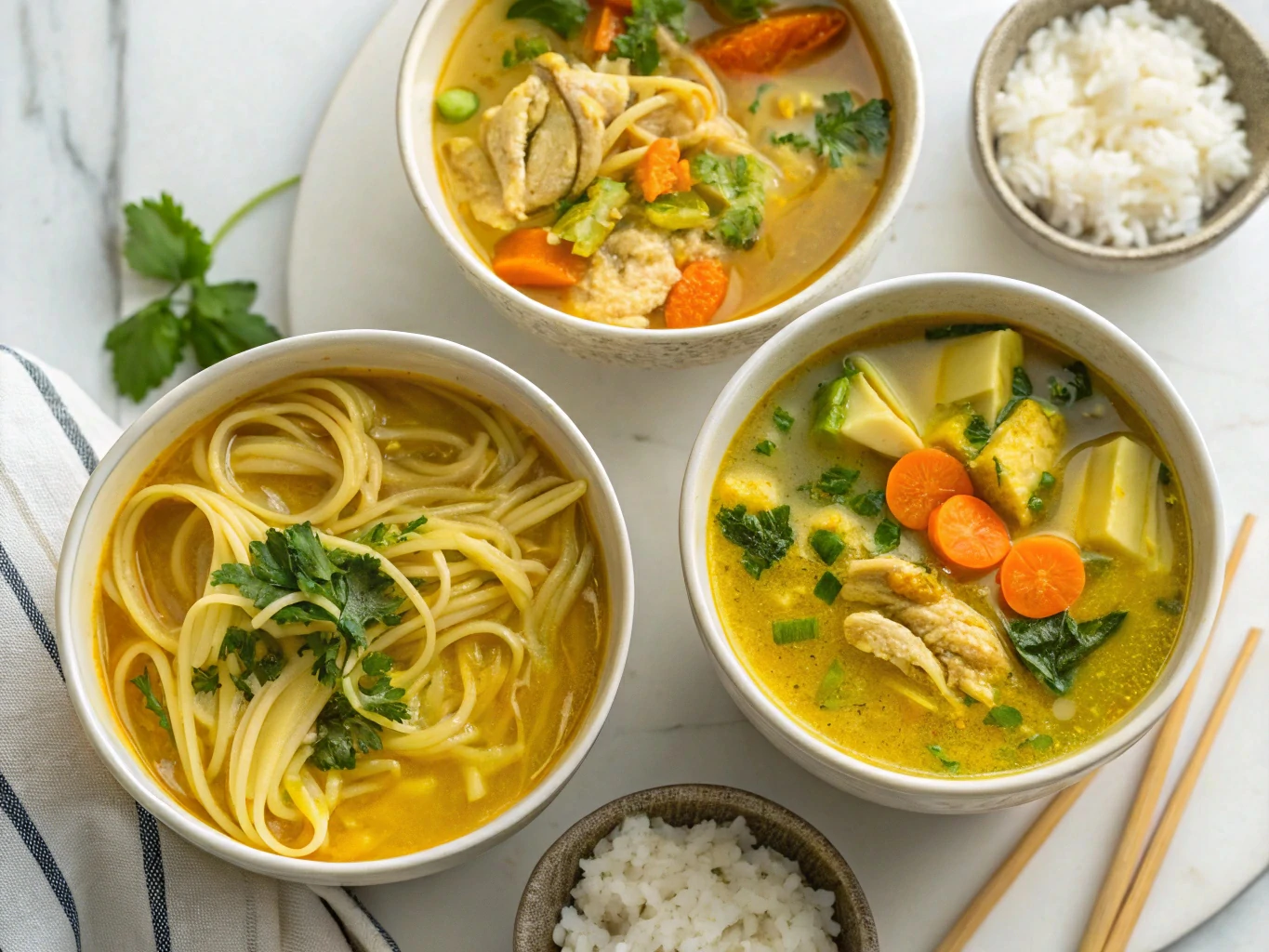
The Science of Anti-Inflammatory Foods
Why does inflammation matter, and how can your diet help? Let’s dive into the science behind anti-inflammatory foods and why this soup is more than just a tasty meal.
Understanding Inflammation
Inflammation is your body’s natural response to injury or infection, like when your ankle swells after a sprain. But chronic inflammation, triggered by stress, poor diet, or lifestyle factors, can contribute to diseases like diabetes, heart disease, and arthritis. A 2020 study in The Lancet noted that chronic inflammation is a key driver of many modern health issues.
Diet’s Role in Fighting Inflammation
What you eat can either fuel inflammation or help tame it. Anti-inflammatory foods like turmeric, ginger, and leafy greens are rich in compounds that reduce inflammatory markers. Harvard Health emphasizes that a diet high in whole foods can significantly lower inflammation.
“Diet plays a critical role in managing inflammation, with spices like turmeric and ginger leading the way.”
Harvard Health
Turmeric and Ginger in the Spotlight
- Turmeric: Studies suggest curcumin may reduce inflammation in conditions like osteoarthritis, with effects comparable to some medications.
- Ginger: Research indicates gingerol can alleviate digestive issues and muscle soreness, making it a natural remedy for post-workout recovery.
Other Anti-Inflammatory Heroes
Incorporate these into your diet for a full-spectrum approach:
- Omega-3s: Found in salmon and chia seeds.
- Berries: Packed with antioxidants.
- Leafy Greens: Rich in vitamins and minerals.
Tips for Flavor and Nutrition
Want to make your turmeric ginger chicken soup even more irresistible? Here are expert tips to elevate flavor and boost nutrition.
Flavor Enhancers
- Black Pepper: A pinch enhances turmeric absorption and adds a subtle kick.
- Fresh Herbs: Parsley, cilantro, or scallions bring freshness.
- Lemon Juice: A squeeze at the end brightens the flavors.
Nutritional Boosts
- Bone Broth: Swap regular chicken broth for bone broth to add collagen and minerals.
- Chickpeas: Toss in for extra fiber and protein.
- Microgreens: Garnish for a nutrient-packed crunch.
Serving Suggestions
- Serve with a slice of crusty bread or over a bed of rice for a heartier meal.
- Pair with a side salad for a balanced plate.
- Garnish with microgreens or a drizzle of olive oil for a gourmet touch.
Personal Anecdote: Last winter, I whipped up a batch of this soup during a cold snap, and it was a game-changer. The ginger warmed me from the inside out, and the leftovers tasted even better the next day. It’s now my go-to for cozy nights!
You can see this:
- Craving more protein-packed meals? Check out our Ground Beef Recipes.
- Pair your soup with Cranberry Pecan Pinwheels for a delicious appetizer.
Frequently Asked Questions
Based on “People Also Ask” questions, here are answers to common queries about turmeric ginger chicken soup.
What Are the Health Benefits of Turmeric and Ginger?
Turmeric and ginger are packed with anti-inflammatory and antioxidant compounds. Curcumin in turmeric may reduce inflammation, while gingerol in ginger supports digestion and immunity.
Is Chicken Soup Really Good for Colds?
Yes! A 2000 study in Chest found that chicken soup can reduce upper respiratory symptoms and improve hydration, making it a go-to remedy for colds.
How Can I Make Chicken Soup More Nutritious?
Add nutrient-dense ingredients like spinach, kale, or bone broth. Incorporate chickpeas or lentils for extra protein and fiber.
Can I Use Fresh or Ground Turmeric and Ginger?
Both work! Fresh turmeric and ginger offer a bolder flavor, while ground versions are more convenient. Use 1 tsp ground for every 1 tbsp fresh.
How Long Does Homemade Chicken Soup Last?
Refrigerate for up to 4 days or freeze for up to 4 months in airtight containers. Reheat gently to preserve flavor.
Conclusion
Anti-inflammatory turmeric ginger chicken soup is more than just a meal it’s a celebration of flavor, health, and comfort. From the science-backed benefits of turmeric and ginger to a versatile recipe that you can make your own, this guide has everything you need to create a nourishing bowl of goodness. Whether you’re soothing a cold, fueling your body with high-protein ingredients, or simply craving a cozy dinner, this soup delivers. So grab your pot, gather your ingredients, and start cooking!
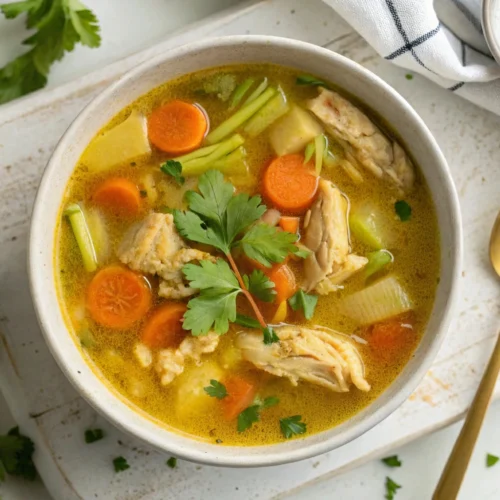
Turmeric Ginger Chicken Soup (Anti-Inflammatory, High-Protein)
Equipment
- Large Pot
Ingredients
Soup Base
- 1 tbsp olive oil
- 1 yellow onion diced
- 2 carrots chopped
- 2 celery ribs chopped
- 4 cloves garlic minced
- 1 tbsp fresh ginger grated
- 1 tbsp fresh turmeric grated or 1 tsp ground turmeric
- 1 bay leaf
- 6 cups chicken broth low-sodium
- 1 pound chicken breasts boneless, skinless
- salt and pepper to taste
Optional Add-ins
- 2 cups kale or spinach chopped
- 1 cup cooked brown rice or quinoa
- 1 lemon juiced
- cilantro or parsley for garnish
Instructions
- Heat olive oil in a large pot. Add onion, carrots, and celery. Sauté until softened, about 5 minutes.
- Add garlic, ginger, and turmeric. Cook for 2 minutes until fragrant.
- Add chicken broth and bay leaf. Bring to a boil.
- Add chicken breasts. Reduce heat and simmer for 15-20 minutes until cooked through.
- Remove chicken and shred with forks. Return to the pot.
- Add greens and cooked rice or quinoa. Simmer for 5 more minutes.
- Stir in lemon juice. Season with salt and pepper. Garnish with herbs and serve.
